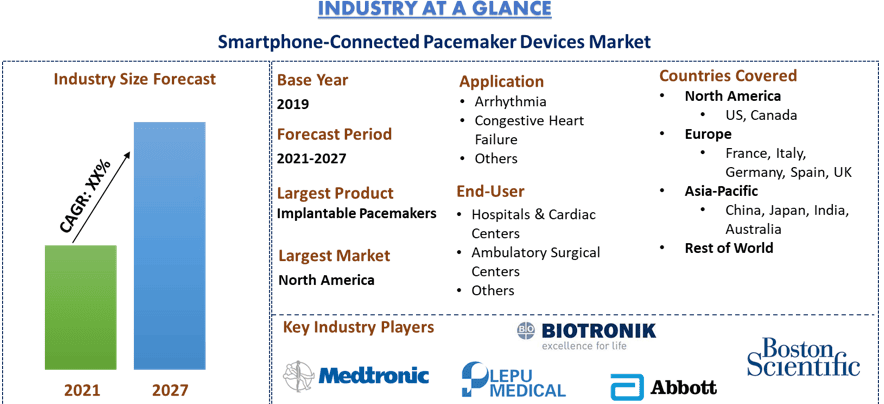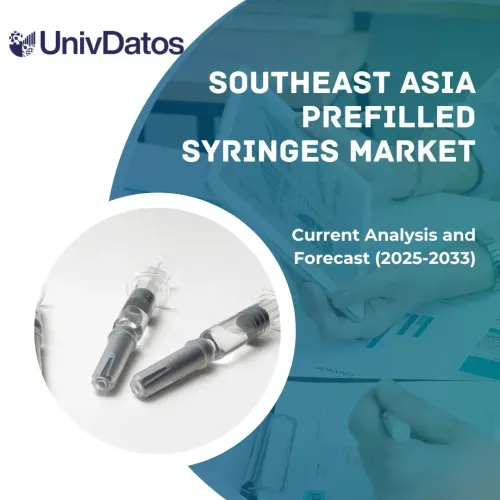- Home
- About Us
- Industry
- Services
- Reading
- Contact Us
Smartphone-Connected Pacemaker Devices Market: Current Analysis and Forecast (2021-2027)
Emphasis on Product (Implantable Pacemakers, External Pacemakers); Type (MRI-Compatible Pacemakers, Conventional Pacemakers); Application (Arrhythmia, Congestive Heart Failure, Others); End-User (Hospitals & Cardiac Centres, Ambulatory Surgical Centers, Others) and Region & Country.
The positive impact of smartphone-connected pacemaker devices is remote monitoring of cardiac rhythm-related vital data. This has to lead the patient better outcomes and a reduced burden on the healthcare system. It provides the patient ability to connect with their doctors anytime, even while they are away from home. These advanced technologies and innovations help to strengthen the engagement between patients, caregivers, and doctors for better healthcare delivery. For instance, Abbott on 18 Feb 2020 announced that it has received CE Mark for their new product “Gallant” an implantable cardioverter-defibrillator (ICD) and cardiac resynchronization therapy defibrillator (CRT-D) devices, which is bringing the most advanced heart rhythm management capabilities along with a new set of benefits to people with cardiovascular diseases with additional benefits like patient preferred design, improved battery longevity, and MRI compatibility. These types of devices offer new opportunities for patient engagement and remote monitoring through smartphone connectivity and connected applications which will upsurge the smartphone-connected pacemaker devices market in the forecast period.
Moreover, the healthcare industries focus on the advancement of pacemakers with multi-functional abilities and the introduction of government-approved smartphone-connected MRI-conditional pacemaker devices are rising the trend for the evolution of more connected pacemakers in the upcoming times. Recently, different companies are launching their new applications through which pacemaker devices are connected. For instance, according to MedtechDive in October 2020, Medtronic became the first company to introduce a mobile app that communicates directly with a smartphone-connected pacemaker in 2019. The app, MyCareLink Heart, eliminates the need for patients to use a dedicated bedside monitor and transmit their different data like information about the device’s battery and heart-related vital results. Additionally, this app will also share these results with their physicians in real-time. The new evolutions happening in the healthcare sector are upsurging the growth of smartphone-connected pacemaker devices in the upcoming period.
Non-MRI vs. MRI Conditional Pacemaker Implantations from 2009 till June 2019 in CIMS Hospital, India
Medtronic PLC, Boston Scientific Corporation, BIOTRONIK, LivaNova PLC, Abbott Laboratories, MEDICO SpA, Pacetronix, Osypka Medical, Inc., Lepu Medical Group, and Cook Medical are some of the prominent players operating in the global smartphone-connected pacemaker devices market. Several M&As along with partnerships have been undertaken by these players to facilitate customers with hi-tech and innovative products/technologies.
Insights Presented in the Report
“Amongst Product, implantable pacemakers segment holds the major share”
Based on products, the market is bifurcated into implantable pacemakers and external pacemakers. The implantable pacemakers segment dominated the market in 2020. As, implantable pacemakers help to control the heartbeat of the patient and they can be implanted temporarily or permanently to treat a slow heartbeat after a heart attack, surgery, or medication overdose.
“Amongst Type, MRI compatible pacemakers segment is anticipated to grow at the highest CAGR during the analyzed period”
Based on type, the market is bifurcated into MRI-compatible pacemakers and conventional pacemakers. The MRI compatible pacemaker segment accounted for the major revenue portion in 2020. As the patient having heart conditions or have an implant surgery needs to go with Magnetic Resonance Imaging (MRI) to detect some serious issues and complications.
“Amongst Application, Arrhythmias segment holds the major share”
Based on application, the market is bifurcated into Arrhythmia, Congestive Heart Failure, and Others. The Arrhythmia segment accounted for the major revenue portion in 2020. As the geriatric population is increasing and due to that the rate of Arrhythmia is also increasing.
“Amongst End-User, hospitals & cardiac centers segment holds the major share”
Based on end-user, the market is bifurcated into hospitals & cardiac centers, ambulatory surgical centers, and others. The hospitals & cardiac center segment is anticipated to observe lucrative growth. As they provide superior care to their patients and offer compensations during surgeries.
“North America signifies one of the largest markets of Smartphone-connected pacemaker devices market”
For a better understanding of the market dynamics of the Smartphone-connected pacemaker devices market, a detailed analysis was conducted for different regions across the globe including North America (United States, Canada, and the Rest of North America), Europe (Germany, France, Italy, Spain, United Kingdom and Rest of Europe), Asia-Pacific (China, Japan, India, Australia, and Rest of APAC), and Rest of World. North America constitutes a major market for the Smartphone-connected pacemaker devices industry and generated the maximum revenue in 2020 owing to the presence of key companies and advanced healthcare infrastructures in the region.
Reasons to buy this report:
- The study includes market sizing and forecasting analysis validated by authenticated key industry experts
- The report presents a quick review of overall industry performance at one glance
- The report covers an in-depth analysis of prominent industry peers with a primary focus on key business financials, product portfolio, expansion strategies, and recent developments
- Detailed examination of drivers, restraints, key trends, and opportunities prevailing in the industry
- The study comprehensively covers the market across different segments
- Deep dive regional level analysis of the industry
Customization Options:
Smartphone-Connected Pacemaker Devices Market can further be customized as per the requirement or any other market segment. Besides this, UMI understands that you may have your own business needs, hence feel free to connect with us to get a report that completely suits your requirements.
Table of Content
Analyzing the historical market, estimation of the current market, and forecasting the future market of the Global Smartphone-Connected Pacemaker Devices Market were the three major steps undertaken to create and analyze the adoption of smartphone-connected pacemaker devices in different segments across major regions globally. Exhaustive secondary research was conducted to collect the historical market numbers and estimate the current market size. Secondly, to validate these insights, numerous findings and assumptions were taken into consideration. Moreover, exhaustive primary interviews were also conducted, with industry experts across the value chain of the smartphone-connected pacemaker devices sector. Post assumption and validation of market numbers through primary interviews, we employed a top-down/bottom-up approach to forecast the complete market size. Thereafter, market breakdown and data triangulation methods were adopted to estimate and analyze the market size of segments and sub-segments the industry pertains to. Detailed methodology is explained below:
Analysis of Historical Market Size
Step 1: In-Depth Study of Secondary Sources:
Detailed secondary study was conducted to obtain the historical market size of the smartphone-connected pacemaker devices through company internal sources such as annual report & financial statements, performance presentations, press releases, etc., and external sources including journals, news & articles, government publications, competitor publications, sector reports, third-party database, and other credible publications.
Step 2: Market Segmentation:
After obtaining the historical market size of the smartphone-connected pacemaker devices market, we conducted a detailed secondary analysis to gather historical market insights and share for different segments for major regions. Major segments included in the report are product, type, application, and end-user. Further country-level analyses were conducted to evaluate the overall adoption of Smartphone-connected pacemaker devices in every region.
Step 3: Factor Analysis:
After acquiring the historical market size of different segments and sub-segments, we conducted a detailed factor analysis to estimate the current market size of smartphone-connected pacemaker devices. Further, we conducted factor analysis using dependent and independent variables such as escalating cases of cardiovascular diseases globally and increasing development of technologically innovative pacemakers will upsurge the demand for smartphone-connected pacemaker devices. A thorough analysis was conducted for demand and supply-side scenarios considering top partnerships, merger and acquisition, business expansion, and product launches in the smartphone-connected pacemaker devices industry across the globe.
Current Market Size Estimate & Forecast
Current Market Sizing: Based on actionable insights from the above 3 steps, we arrived at the current market size, key players in the Smartphone-connected pacemaker devices market, and market shares of the segments. All the required percentage shares split, and market breakdowns were determined using the above-mentioned secondary approach and were verified through primary interviews.
Estimation & Forecasting: For market estimation and forecast, weights were assigned to different factors including drivers & trends, restraints, and opportunities available for the stakeholders. After analyzing these factors, relevant forecasting techniques i.e., the top-down/bottom-up approach was applied to arrive at the market forecast about 2027 for different segments and subsegments across the major markets globally. The research methodology adopted to estimate the market size encompasses:
- The industry’s market size, in terms of value (USD) and the adoption rate of smartphone-connected pacemaker devices across the major markets domestically
- All percentage shares, splits, and breakdowns of market segments and sub-segments
- Key players in the smartphone-connected pacemaker devices market in terms of services offered. Also, the growth strategies adopted by these players to compete in the fast-growing market
Market Size and Share Validation
Primary Research: In-depth interviews were conducted with the Key Opinion Leaders (KOLs) including Top Level Executives (CXO/VPs, Sales Head, Marketing Head, Operational Head, and Regional Head, Country Head, etc.) across major regions. Primary research findings were then summarized, and statistical analysis was performed to prove the stated hypothesis. Inputs from primary research were consolidated with secondary findings, hence turning information into actionable insights.
Split of Primary Participants in Different Regions
Market Engineering
Data triangulation technique was employed to complete the overall market estimation and to arrive at precise statistical numbers of each segment and sub-segment of the Smartphone-connected pacemaker devices market. Data was split into several segments & sub-segments post studying various parameters and trends in the areas of product, type, application, and end-user of the smartphone-connected pacemaker devices market.
Main Objective of the Smartphone-Connected Pacemaker Devices Market Study
The current & future market trends of Smartphone-connected pacemaker devices were pinpointed in the study. Investors can gain strategic insights to base their discretion for investments from the qualitative and quantitative analysis performed in the study. Current and future market trends were determined the overall attractiveness of the market at a regional level, providing a platform for the industrial participant to exploit the untapped market to benefit as a first-mover advantage. Other quantitative goals of the studies include:
- Analyze the current and forecast market size of Smartphone-connected pacemaker devices in terms of value (USD). Also, analyze the current and forecast market size of different segments and sub-segments
- Segments in the study include areas of product, type, application, and end-user
- Define and analysis of the regulatory framework for the Smartphone-connected pacemaker devices industry
- Analyze the value chain involved with the presence of various intermediaries, along with analyzing customer and competitor behaviors of the industry
- Analyze the current and forecast market size of the Smartphone-connected pacemaker devices market for the major region
- Major regions studied in the report include North America (the United States and Canada), Europe (Germany, France, Italy, Spain, and United Kingdom), Asia-Pacific (China, Japan, India, and Australia), and Rest of the World
- Company profiles of the Smartphone-connected pacemaker devices market and the growth strategies adopted by the market players to sustain in the fast-growing market
- Deep dive regional level analysis of the industry
Related Reports
Customers who bought this item also bought













